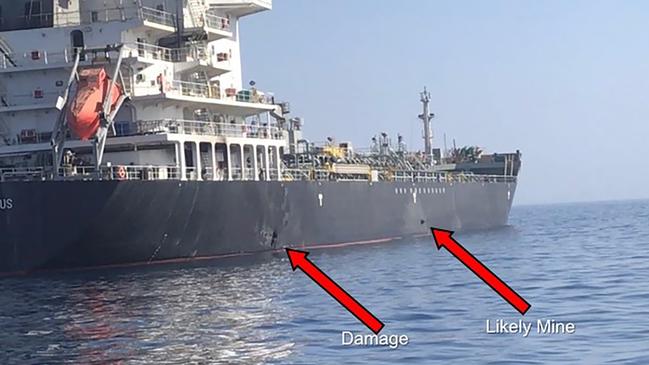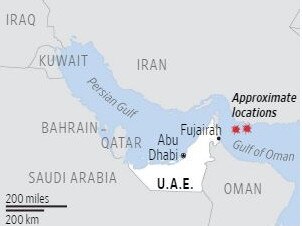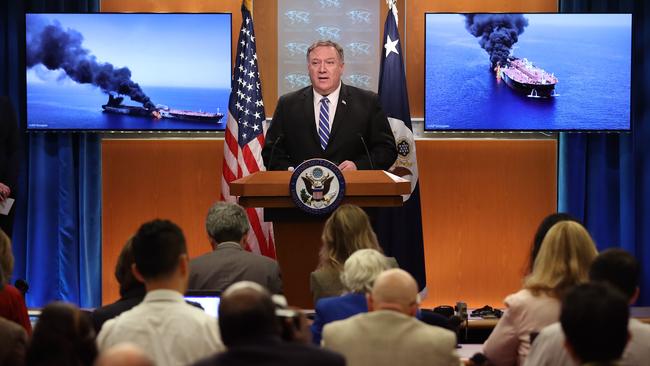Pentagon releases video it says shows limpet mine being removed by Iranian forces
US video allegedly shows Iran removing an unexploded mine from a Gulf tanker | WATCH

The US military has released a video it said showed Iran’s Revolutionary Guard removing an unexploded limpet mine from one of the oil tankers targeted near the Strait of Hormuz, suggesting the Islamic Republic sought to remove evidence of its involvement from the scene.
The US Navy rushed to assist the stricken vessels in the Gulf of Oman off the coast of Iran, including one that was set ablaze Thursday by an explosion.
The ships’ operators offered no immediate explanation on who or what caused the damage against the Norwegian-owned MT Front Altair and the Japanese-owned Kokuka Courageous. Each was loaded with petroleum products, and the Front Altair burned for hours, sending up a column of thick, black smoke.
Iran has denied being involved in the attack, calling it an “unfounded claim” in the US’ “Iranophobic campaign.” However, Iran previously used mines against oil tankers in 1987 and 1988 in the “Tanker War,” when the U.S. Navy escorted ships through the region.
The black-and-white footage, as well as still photographs released by the US military’s Central Command, appeared to show the limpet mine on the Kokuka Courageous.
A Revolutionary Guard patrol boat pulled alongside the ship and removed the mine, Central Command spokesman Capt. Bill Urban said.
“The US and the international community stand ready to defend our interests, including the freedom of navigation,” Urban said. “The United States has no interest in engaging in a new conflict in the Middle East. However, we will defend our interests.”
Iran earlier denied involvement via a statement from its mission to the United Nations.
“The US economic war and terrorism against the Iranian people as well as its massive military presence in the region have been and continue to be the main sources of insecurity and instability in the wider Persian Gulf region and the most significant threat to its peace and security,” the statement said.
Tensions soar
Tensions between the US and Iran have soared after US Secretary of State Mike Pompeo accused Iran of being behind the attacks on two tankers in the Gulf of Oman.

“It is the assessment of the US government that Iran is responsible for today’s attacks in the Gulf of Oman,” Mr Pompeo said in Washington. “This assessment is based on intelligence, the weapons used and the level of expertise needed to execute the operation.
“These attacks are a threat to international peace and security, a blatant assault on the freedom of navigation, and an unacceptable escalation of tension by Iran.”
The attacks on two petrochemical tankers off the coast of Iran have caused oil prices to spike amid concerns of disruptions to tanker flows in the Strait of Hormuz, through which more than one third of seaborne crude oil is shipped.

One of the two tankers attacked was Japanese-owned with the assault coinciding with a visit to Iran by Japan’s Prime Minister Shinzo Abe aimed as reducing tensions in the region between Washington and Tehran.
Donald Trump said Mr Abe’s visit was too soon because neither the US or Iran was ready to talk.
“While I very much appreciate PM Abe going to Iran to meet with the Ayatollah Ali Khamenei, I personally feel that it is too soon to even think about making a deal,” the president tweeted. “They are not ready and neither are we.”
While I very much appreciate P.M. Abe going to Iran to meet with Ayatollah Ali Khamenei, I personally feel that it is too soon to even think about making a deal. They are not ready, and neither are we!
— Donald J. Trump (@realDonaldTrump) June 13, 2019
The two attacks forced the crews to abandon ship and left one of the tankers ablaze.
The US accusation that Iran was behind the attacks will further ratchet up tension between the two countries after several months of deteriorating relations.
In May Mr Trump ordered an US aircraft carrier group and a missile battery to the region in response to US intelligence assessments that Iran may be planning to attack US forces or assets in the region. The US will also send around 1500 more troops to the region.
In early May four tankers were attacked in near the mouth of the Persian Gulf with the US accusing Iran of orchestrating the attacks.
Iran has threatened to shut down the Strait of Hormuz if it cannot export oil. The country’s economy has been hit hard by tough US financial sanctions imposed last November after the US withdrew from the nuclear deal with Iran.
At least one of tankers was believed to have been attacked by limpet mines attached to the side of the ship.
The Norwegian-owned Front Altair tanker caught fire after an explosion although the Norwegian Maritime Agency said the cause of the explosion was unclear.
Aerial footage shows one of the oil tankers targeted in the Sea of Oman#SeaofOman pic.twitter.com/mdvEPPT3J4
— Press TV (@PressTV) June 13, 2019
The second tanker, the Japanese-owned Kokura Courageous, was “attacked twice’’ with “some sort of shell’’ according to the ship’s co-manager Michio Yuube. Mr Pompeo said the assaults on the tankers were “only the latest in series of attacks instigated by (Iran) against American and allied interests”.
“On April 22 Iran promised the world it would interrupt the flow of oil through the Strait of Hormuz, it is now working to execute that promise,” he said.
Despite the attacks Japan’s Mr Abe said his visit to Iran had been “a major step toward securing peace and stability in the region’’.
Although the Trump administration has adopted a much tougher stance against Iran than did the Obama Administration, the president has also said he does not want war with Iran.
(Cameron Stewart is also US Contributor for Sky News Australia)
with AP




To join the conversation, please log in. Don't have an account? Register
Join the conversation, you are commenting as Logout